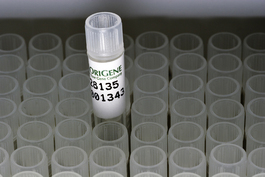FE65 (APBB1) (NM_001257321) Human Untagged Clone
CAT#: SC330598
APBB1 (untagged) - Homo sapiens amyloid beta (A4) precursor protein-binding, family B, member 1 (Fe65) (APBB1), transcript variant 4
"NM_001257321" in other vectors (2)
Product Images

Specifications
| Product Data | |
| Type | Human Untagged Clone |
| Tag | Tag Free |
| Symbol | APBB1 |
| Synonyms | FE65; MGC:9072; RIR |
| Vector | pCMV6 series |
| Sequence Data |
>NCBI ORF sequence for NM_001257321, the custom clone sequence may differ by one or more nucleotides
ATGAGGGTCCAGGACACCTCAGGGACCTATTACTGGCACATCCCAACAGGGACCACCCAGTGGGAACCCC CCGGCCGGGCCTCCCCCTCACAGGGGAGCAGCCCCCAAGAGGAGTCCCAGCTCACCTGGACAGGTTTTGC TCATGGAGAAGGCTTTGAGGATGGAGAATTTTGGAAGGATGAACCCAGTGATGAGGCCCCAATGGAGCTG GGACTGAAGGAACCTGAGGAGGGGACGTTGACCTTCCCAGCTCAGAGCCTCAGCCCAGAGCCGTTGCCCC AAGAGGAGGAGAAGCTTCCCCCACGGAATACCAACCCAGGGATCAAGTGTTTCGCCGTGCGCTCCCTAGG CTGGGTAGAGATGACCGAGGAGGAGCTGGCCCCTGGACGCAGCAGTGTGGCAGTCAACAATTGCATCCGT CAGCTCTCTTACCACAAAAACAACCTGCATGACCCCATGTCTGGGGGCTGGGGGGAAGGAAAGGATCTGC TACTGCAGCTGGAGGATGAGACACTAAAGCTAGTGGAGCCACAGAGCCAGGCACTGCTGCACGCCCAACC CATCATCAGCATCCGCGTGTGGGGCGTCGGGCGGGACAGTGGAAGAGAGAGGGACTTTGCCTACGTAGCT CGTGATAAGCTGACCCAGATGCTCAAGTGCCACGTGTTTCGCTGTGAGGCACCTGCCAAGAACATCGCCA CCAGCCTGCATGAGATCTGCTCTAAGATCATGGCCGAACGGCGTAATGCCCGCTGCTTGGTAAATGGACT CTCCCTGGACCACTCTAAACTTGTGGATGTCCCTTTCCAAGTGGAATTCCCAGCGCCTAAGAATGAGTTG GTCCAGAAGTTCCAAGTCTATTACCTGGGGAATGTACCTGTTGCTAAACCTGTTGGGGTAGATGTGATTA ATGGGGCCCTCGAGTCAGTCCTGTCCTCCAGCAGCCGTGAACAATGGACCCCAAGTCATGTCAGTGTGGC CCCTGCTACCCTCACCATCTTGCACCAGCAGACAGAGGCAGTGCTGGGAGAGTGTCGGGTGCGTTTCCTC TCCTTCCTGGCCGTGGGCAGAGATGTCCACACGTTTGCATTCATCATGGCTGCCGGCCCAGCCTCCTTCT GCTGCCACATGTTCTGGTGCGAGCCCAATGCTGCCAGCCTCTCAGAGGCTGTGCAGGCTGCGTGCATGCT TCGCTACCAGAAGTGTCTGGATGCCCGTTCCCAGGCCTCCACCTCCTGCCTCCCAGCACCCCCTGCTGAG TCTGTGGCACGGCGTGTAGGGTGGACTGTCCGCAGGGGTGTTCAGTCGCTGTGGGGCTCCCTGAAGCCCA AACGGCTGGGGGCCCATACCCCATGA |
| Restriction Sites | SgfI-MluI |
| ACCN | NM_001257321 |
| OTI Disclaimer | Our molecular clone sequence data has been matched to the reference identifier above as a point of reference. Note that the complete sequence of our molecular clones may differ from the sequence published for this corresponding reference, e.g., by representing an alternative RNA splicing form or single nucleotide polymorphism (SNP). |
| Product Components | The cDNA clone is shipped in a 2-D bar-coded Matrix tube as dried plasmid DNA. The package also includes 100 pmols of both the corresponding 5' and 3' vector primers in separate vials. Every lot of primer is tested to provide clean sequencing of OriGene TrueClones. |
| Reconstitution | 1. Centrifuge at 5,000xg for 5min. 2. Carefully open the tube and add 100ul of sterile water to dissolve the DNA. 3. Close the tube and incubate for 10 minutes at room temperature. 4. Briefly vortex the tube and then do a quick spin (less than 5000xg) to concentrate the liquid at the bottom. 5. Store the suspended plasmid at -20°C. The DNA is stable for at least one year from date of shipping when stored at -20°C. |
| Reference Data | |
| RefSeq | NM_001257321.2, NP_001244250.1 |
| RefSeq Size | 2162 bp |
| RefSeq ORF | 1356 bp |
| Locus ID | 322 |
| Cytogenetics | 11p15.4 |
| Protein Families | Transcription Factors |
| Protein Pathways | Alzheimer's disease |
| Gene Summary | 'The protein encoded by this gene is a member of the Fe65 protein family. It is an adaptor protein localized in the nucleus. It interacts with the Alzheimer's disease amyloid precursor protein (APP), transcription factor CP2/LSF/LBP1 and the low-density lipoprotein receptor-related protein. APP functions as a cytosolic anchoring site that can prevent the gene product's nuclear translocation. This encoded protein could play an important role in the pathogenesis of Alzheimer's disease. It is thought to regulate transcription. Also it is observed to block cell cycle progression by downregulating thymidylate synthase expression. Multiple alternatively spliced transcript variants encoding different isoforms have been described for this gene. [provided by RefSeq, Mar 2012]' Transcript Variant: This variant (4) represents use of an alternate promoter and thus differs in the 5' UTR and 5' coding region compared to variant 1. These differences cause translation initiation at a downstream start codon and result in an isoform (d) with a shorter N-terminus, compared to isoform 1. Variants 4, 5, and 6 all encode the same isoform (d). |
Documents
| Product Manuals |
| FAQs |
Resources
Other Versions
| SKU | Description | Size | Price |
|---|---|---|---|
| RC232764 | APBB1 (Myc-DDK tagged) - Homo sapiens amyloid beta (A4) precursor protein-binding, family B, member 1 (Fe65) (APBB1), transcript variant 4 |
USD 420.00 |
|
| RG232764 | APBB1 (GFP-tagged) - Homo sapiens amyloid beta (A4) precursor protein-binding, family B, member 1 (Fe65) (APBB1), transcript variant 4 |
USD 460.00 |
{0} Product Review(s)
Be the first one to submit a review






























































































































































































































































 Germany
Germany
 Japan
Japan
 United Kingdom
United Kingdom
 China
China
